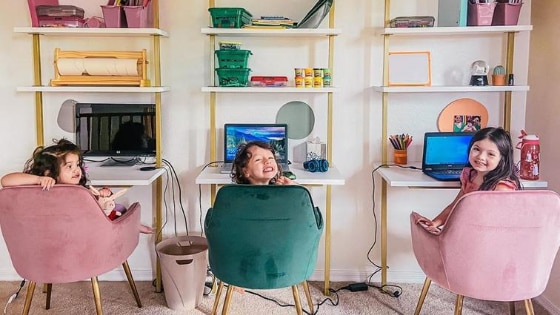Whether your kids are distance learning, following a hybrid schedule or attending typical in-person school days, followed by homework after school, one thing is a guarantee this year: An at-home kids workspace is essential.
While some parents are getting super creative when it comes to setting up a learning space for their kids, keep in mind an elaborate workspace for children isn’t essential. In fact, getting your child’s input — even if it means making a space that’s much more kid-friendly and slightly less Instagram-worthy — can make for a more productive learning area. Elanna Yalow, chief academic officer for KinderCare Education who has a doctorate in educational psychology, says, “Ask your child what they think they’ll need in the space. This will help them get in the ‘school’ mindset even if they’re learning at the dining room table.”
From storage solutions and organizational ideas to serious space savers, here are 11 tips for setting up a cool workspace for kids.
1. Start off simple

While you may get the gnawing desire to ransack Target or The Container Store after bingeing on distance learning spaces on Pinterest, it’s best to start off simply with a setup similar to this one from Our Full Hearted House. (This is an ever-evolving situation, remember? In a few months from now, you may not need three filing cabinets and a chalkboard wall.)
“Don’t go overboard in the beginning,” suggests professional organizer and owner of Appleshine Organization and Design Amelia Meena. “Start with the basics, and add as you go to avoid clutter and congestion in your new learning space.”
2. Post their daily schedule

“For older kids, posting a written breakdown of their day on a bulletin board in front of them can be helpful, as it will help them understand what’s coming up,” says Yalow. She also recommends building in breaks for kids who are learning remotely. “Knowing that there’s a break after a lesson not only gives your child something to look forward to, it also helps them understand that their lesson won’t go on for the entire day,” says Yalow.
This bulletin board setup from Melissa Berg is perfectly simple — and cute.
3. Add in some cozy

This distance learning setup from Blue Ticking features a cozy corner. Just as teachers make their classrooms fun and inviting, at-home learning spaces should have a little personality, too.
“Try to find a comfortable workspace for your child, and let them decorate it to make it their own,” notes Yalow. “Pillows and pictures are fine and can provide comfort rather than distractions. It’s OK to personalize the space with family photos, pictures of pets and so forth. Think about what gives you comfort while you’re working — the same goes for your child.”
4. Tune out the noise

Most people can be easily distracted when it comes to work, and kids certainly are no exception. While the majority of parents likely don’t have the space to create a completely isolated area for each child, a DIY cubicle, like the one mom Angelina Harper created, is a close (and portable!) second.
For kids who need a little extra help focusing, other measures can be taken, too. “Some children may need help filtering out distractions,” Yalow says. “Noise-cancelling headphones can help kids focus. Another option can be to give kids a piece of paper with a stop sign on one side (‘Not ready to talk’) and a green light on the other (‘Ready to talk’). This may help other family members understand when a child needs time alone to study.”
5. Utilize clear boxes

When kids (particularly little kids) start school, they have all the things: papers, projects, crayons, Post-Its. You’d think they were running a mini corporation! In order to combat everything getting jumbled together in one messy drawer (as it’s wont to do), Meena suggests utilizing clear, lidded boxes. “I love them because they make it easy to divide subjects or projects while still being able to see the contents,” she explains.
Where to buy: mDesign Stackable Bins ($45 for 6, Amazon)
6. Designate an area for learning

Whether it’s a corner of your child’s bedroom or a scarcely used dining room table, having a space solely dedicated to schoolwork, like these three cute desks via Cindy Garcia, will make life easier — for everyone.
“Parents should pick an area of the house for home schooling and/or homework and transform the space to fit everyone’s needs,” says Meena. “Taking a recess break outside is great, but otherwise it’s best to keep all learning materials in a singular environment, as it will help parents maintain a sense of control.”
7. Use chalkboard labels

Reusable labels are great on boxes and bins — particularly when there’s more than one child using school supplies at home. “Reusable chalkboard labels make it easier for multiple people to follow a single organization system and ensure things get put back where they belong,” says Meena. For kids who can’t yet read, try drawing a picture of the contents inside each bin or box.
Where to buy: Arteza Chalkboard Labels ($8 for 150, Walmart)
8. Use a rolling cart

Shelving units and bookcases are great for storage and organization, but they generally take up a lot of space. An effective alternative? A rolling cart like this one Calynn from Bryn N Nora set up. “A small cart on wheels with shelves has a small footprint with a large holding capacity,” notes Meena. Also, let’s be honest: They’re cute.
Where to buy (similar cart): Blush 3-Tier Rolling Cart ($35, The Container Store)
9. Keep writing utensils together

Face it, parents. You can have a million pens, pencils and highlighters in your home, but when the time comes for your child to sit down to work, they won’t be able to find one. The solution? Pen and pencil holders that are forever in reach, like this sweet desk set-up from Study PLR. “Always keep all writing materials and tools at the ready in your child’s learning area in an easy-to-see container,” says Meena.
Where to buy (similar pencil cup): U Brands Copper/Rose Gold Pencil Cup ($8, Amazon)
10. Create a classroom with “friends”
If possible, recreate a virtual classroom in real life for your child. “Post a screen capture of the class Zoom call, along with everyone’s names,” suggests Yalow. “Or if photos aren’t available, engage your child’s creative side and have them draw their own pictures of classmates. This way, they can feel as though they’re with their friends, even at home.”
11. Sprinkle in some typical classroom items

While no area in your home will ever replicate a classroom to a tee, sprinkling a few typical classroom items throughout your child’s workspace can help bring in some of that school energy. “Ask your child’s teacher for suggestions of things to include that would traditionally be in a classroom, such as a child-sized calendar,” suggests Yalow.
Where to buy: Today’s Calendar Pocket Chart ($40, Really Good Stuff)







